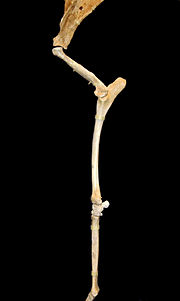| This article needs additional citations for verification. Please help improve this article by adding citations to reliable sources. Unsourced material may be challenged and removed. Find sources: "Megatylopus" – news · newspapers · books · scholar · JSTOR (June 2022) (Learn how and when to remove this message) |
| Megatylopus Temporal range: Late Miocene-Late Pliocene (Hemphillian-Blancan) ~10.3–2.58 Ma PreꞒ Ꞓ O S D C P T J K Pg N | |
|---|---|

| |
| Front limb bone of Megatylopus | |
| Scientific classification | |
| Domain: | Eukaryota |
| Kingdom: | Animalia |
| Phylum: | Chordata |
| Class: | Mammalia |
| Order: | Artiodactyla |
| Family: | Camelidae |
| Subfamily: | Camelinae |
| Tribe: | Camelini |
| Genus: | †Megatylopus Matthew & Cook, 1909 |
| Type species | |
| †Pliauchenia gigas | |
| Species | |
| |
Megatylopus (also known as the North American camel) is an extinct genus of large camel, endemic to North America from the Late Miocene to the Pliocene, existing for approximately 7.4 million years. Fossil distribution ranged from North Carolina to California. It stood about 4.2 metres (14 ft) tall.
References
| Taxon identifiers | |
|---|---|
| Megatylopus | |
 | This prehistoric even-toed ungulate-related article is a stub. You can help Misplaced Pages by expanding it. |